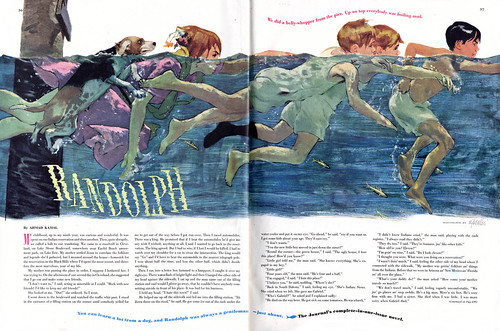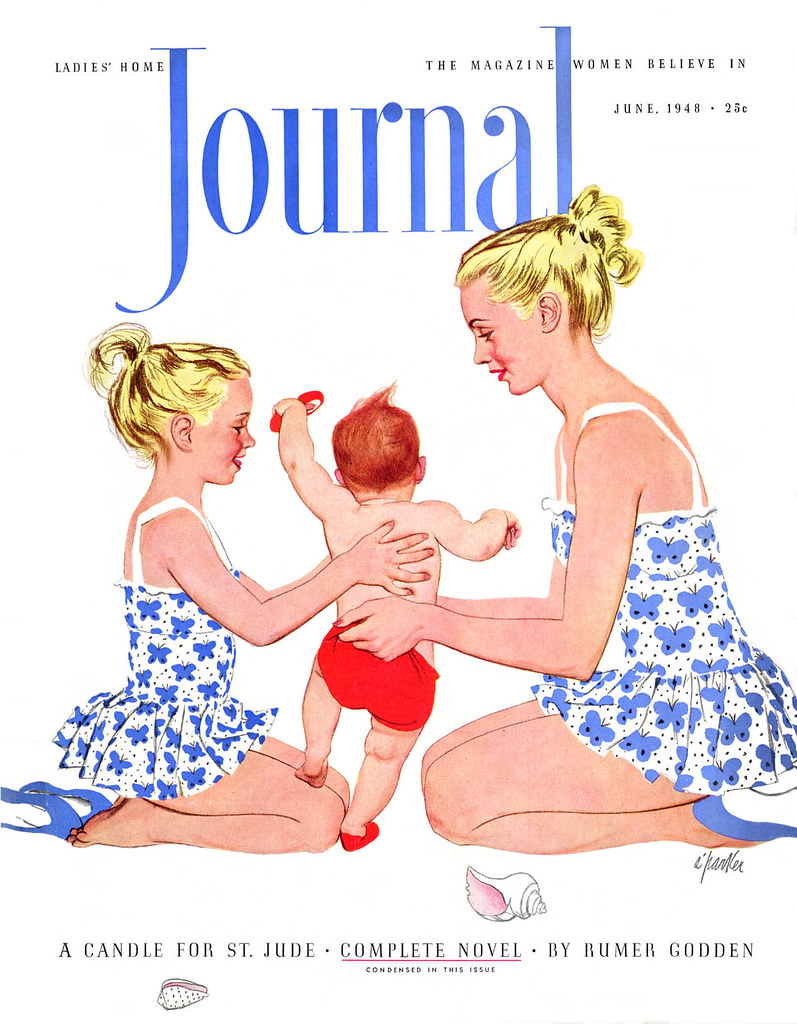
When Barbara Bradley and I began collaborating on this past week's look at Al Parker's work, it quickly became apparent that we would need to spend a day focusing on the artist's illustrations of children. Childhood is not all sweetness and light... it's often frought with danger, mystery and confusion and Parker seems to have been innately attuned to the complexities of children and the world they live in.
"I think that one of Parker's most wonderful talents was his uncanny ability to catch believable attitudes [in children] that we mortals wouldn't think of", wrote Barbara in one earlier email, and she begins her elaboration on the topic below...

"Leif, you have selected three of my favorites, all of which demonstrate several aspects of Parker’s genius. They are all wonderfully human, fresh and real in every gesture. The gestures, facial expressions, clothing, and props are not only perfect for the time period of and story of each but are fresh and interesting. Parker seemed incapable of using a visual cliché. Every prop adds to the story while simultaneously becoming an essential part of the composition. Each illustration is so masterfully designed that we can all profit by analyzing the elements in its composition, the contrast of large and small masses, masses to delicate, the contrast of curves and straights, static to dynamic, the beautiful negative spaces, etc. I smile with wonder every time I view these."
THE HIGHER LAW
"The gestures of the boys are so natural but how few of us artists would think of capturing them: the boy wiping his nose in the cold, the one warming his hand under his armpit. Having decided that they would all face forward, Parker arranged their shapes within the composition so that there was no monotony such as overlapping the vertical boys on the left."

"The vertical figure on the right combines with the shape of the diagonal boy behind to make one larger shape. The sleds make a terrific pattern that echoes the curve of the snow, at the same time they break it up. Look at the variety within the negative shape of the background around the foreground. Then, look how the delicate linear branches on the left and lamppost on the right contrast with the solid foreground mass of the foreground and add to the time and place. It’s modeled in the figures, flat white in the snow, slightly horizontally textured in the sky, partially flat in the sleds. It’s mostly muted in color, appropriate for winter, with lush accents of more intense color. Beautiful snowball splats… and,the Parker accent touch, the cap in the snow."
THE RICH WOMAN
"It’s fascinating to study how Parker used design elements to hint at an intriguing story that aroused curiosity and lured viewers: The curve of the woman’s back turned away from the diagonal of the contemplative child; The horizontal line of dresser and table that pulls the figures together while establishing the period and setting; The rug with a naturally upturned corner that also relates them; A purse that breaks up the severity of the dresser; The array of period props, all carefully placed and selected in size, shape, color, and texture."

"Most of the color is deliciously muted, contrasting with the comparative brightness of the exquisitely designed quilt. Best of all is the child. She is typically Parker. Her gesture with arms behind the chair and crossed feet is completely natural, uncontrived, yet unexpected. The natural use of one sock on and one in a hand to establish interrupted dressing is pure Parker. So is the ribbon around the neck. To me, this illustration is a masterpiece."
RANDOLPH
"This must be such a delight to all of us viewers that I suspect we are enjoying many of the same storytelling elements: the charming dog, paddling for all its worth; the natural swimming actions of the children, wet flowers dangling from the girl’s hair; the boy hanging on to his ballooning pants; the loosely painted water; and the effects of sun flashing through the water onto flesh, fabric, or fur. Parker’s composition is once again superb."

"Horizontal water contrasting with diagonal swimmers and slightly off vertical pier. Diagonals to the right balanced by the diagonal of fish through knees toward the left. Pier leading out of page stopped by sign. Large water shimmering curve of title repeated in thin curves of red and blue headings. Overlap of heads of the twins to contribute to the variety of head shapes. (Check out the pleasing never-monotonous negative spaces around the heads and around the swimming figures.) Beautiful repeat of blacks of one sock, head, and dog. And even the contrast of the upper edge of water to its dragged lower edge."
"Thank you, Leif, for giving me the privilege of discussing a few of the delights and depths of the work of my favorite illustrator, Alfred Parker."
"I hope that another time, you will run a few of over a hundred of Parker’s Mother/daughter covers for Ladies’ Home Journal. Each is a gem, a masterful little poster, and together they document an era."

My thanks to Barbara Bradley for providing us such invaluable analysis of Al Parker's work - its been incredibly enjoyable and educational to have the benefit of her tremendous knowledge and passion for this week's subject.
Last week, as we were working on the material for these posts, Barbara related the following anecdote to me. It seems like an entirely appropriate way to bring our look at Al Parker to a close:
"One thing I can tell you about what other artists thought about Parker was when Rockwell was a guest speaker at Art Center. We students, being jaded, sophomoric, and mostly interested in the most current cool work, politely went to hear him. Of course, he was so natural and charming that he had us in the palms of his hands within minutes."

"When a student asked what he thought of illustrators of the day, he mentioned only Parker, saying he was “just great”. To describe his thoughts on Parker he told a story about a parade in a small town. Behind the band followed the kids, busily copying the band members, blowing on imaginary trombones and banging on imaginary bass drums. They were so busy imitating the movements that they didn’t notice when the band turned a corner. The kids marched on, banging their drums and sliding their trombones, by then following a garbage truck. Parker was the band and his imitators were the kids following."
*Barbara Bradley is an illustrator who began her career in the early 1950's at the famous Cooper studio in New York. She later moved to San Francisco and eventually went on to become the Director of Illustration at the Academy of Art University. Barbara knew Al Parker personally and professionally and I am most grateful for the keen insight she has so generously offered to add to this week's posts. Barbara was recently fêted at The Society of Illustrators in New York. She received the Distinguished Educator of the Arts Award for 2007.
Barbara's fascinating career will be the topic of an upcoming week here at Today's Inspiration but in the meantime, take a moment to visit this blog which was set up in her honor.
*The Norman Rockwell Museum is about to showcase Al Parker's work in a major retrospective. Go to the Rockwell Museum's site for more information.
It's astounding how many professional artists have trouble with rendering kids. A lot of people draw kids like adult midgets. Of course, Parker never had that problem, as I've noticed. :)
ReplyDelete